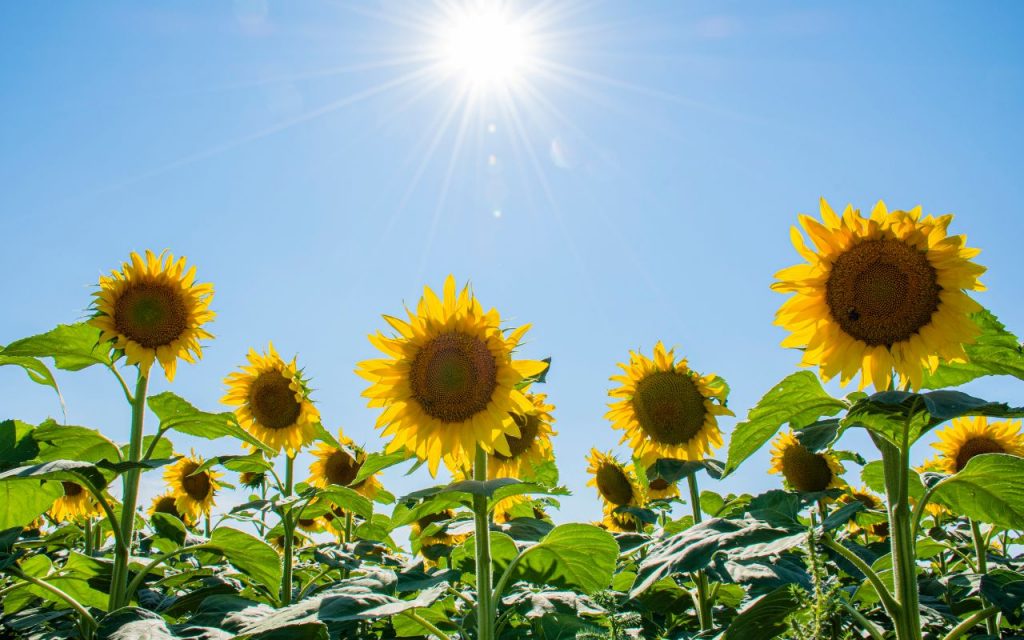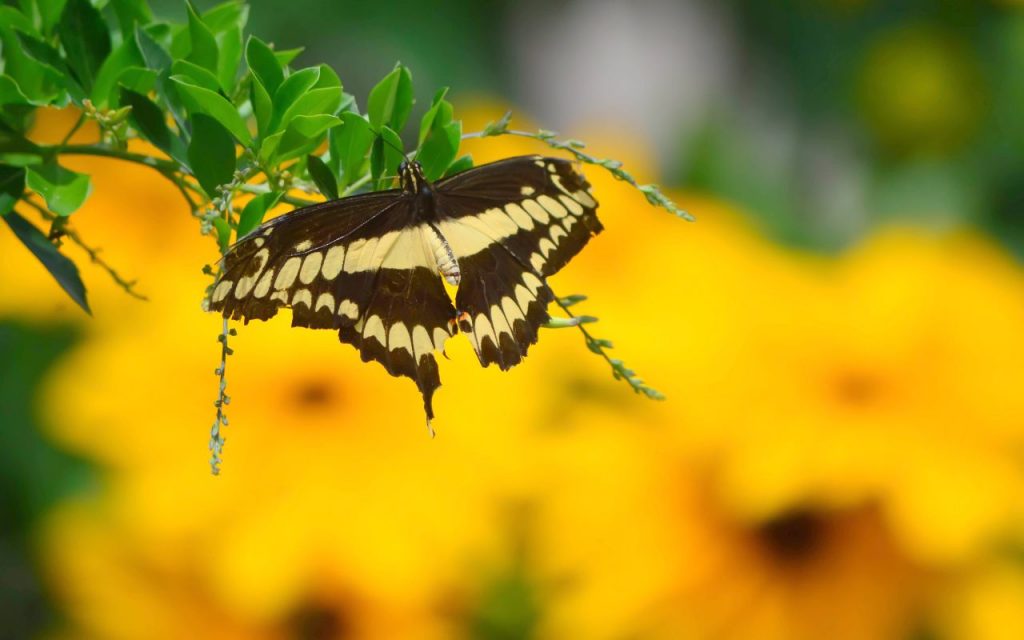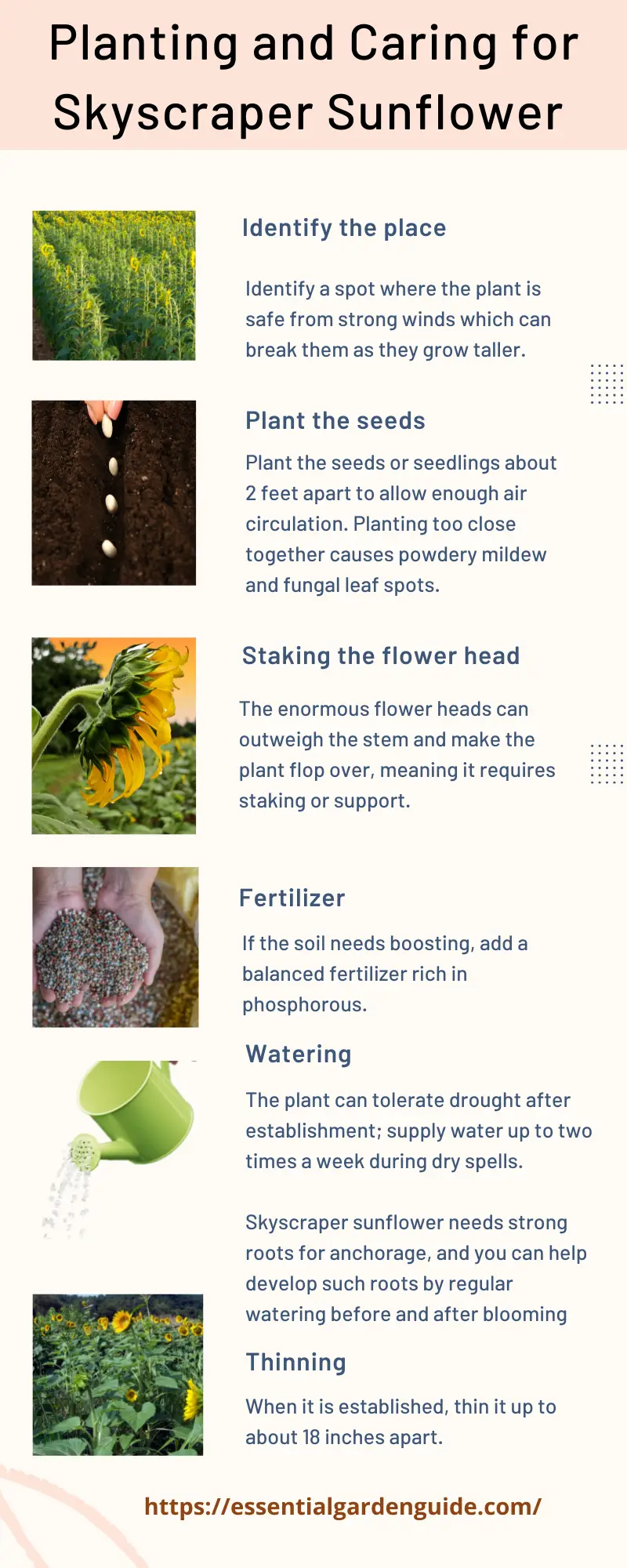
How to care for Skyscraper Sunflowers
Photo from Essential Garden Guide
Originally Posted On: https://essentialgardenguide.com/how-to-care-for-skyscraper-sunflowers/
Skyscraper Sunflower Scientific Name
Skyscraper sunflower is a variety of common sunflower, and it is native to the U.S and Central America. Its scientific name is Helianthus annuus ‘skyscraper’. It is one of the tallest sunflowers that can grow in a garden. It derives its name from its habit of moving with the sun as it rounds through the horizon.
Not many flowers can compete with the height of a skyscraper sunflower of up to 12 feet and blooms that can reach 14 inches in width. Unlike other sunflower cultivars, it produces bright yellow flowers that can have different flower colors.
Skyscraper Sunflower Height
A skyscraper attains a mature height of about 12 feet and produces 14-inch across blooms. Its size is excellent for growing in back gardens and forests as a plant shade due to its height. Their height also enables them to benefit from staking, and you can grow them near a garage, fence, or on tall screens.
Every skyscraper sunflower grower determines their success with the plant by how tall it grows; some may go up to 20 feet tall. The difference comes in the growing conditions. Generally, the taller the plant, the higher the sunflower seed yield.
Why Skyscraper Sunflower Grows So Tall
Like all plants, the skyscraper sunflower requires sunlight for photosynthesis and maximum growth. Like the canopy in deep forests strives to reach sunlight, so has the skyscraper sunflower adapted to tap full sunlight with its height.
The sunlight activates photosynthesis and accelerates cell growth rate, leading to an extensive increase in the plant’s height.
Effect of Sunlight on the Height of Skyscraper
Unknown to most growers, the amount of sunlight a skyscraper sunflower receives significantly impacts its height. If you grow it in a cloudy spot with low temperatures, the plant will be shorter and produce fewer seeds.
All plants practice heliotropism, where the plant turns to face the sun and grows on the side from where the sun shines the most. Skyscraper sunflower has the advantage of this process over shorter sunflower varieties. Its height allows it to turn towards the sun without objection freely.
Skyscraper Sunflower Care
Skyscraper sunflower is a hardy annual easy to grow and maintain and has dark green heart-shaped leaves. It is suitable for climates similar to hardiness zones 3 to 9 USDA. It grows under similar conditions to other sunflower cultivars, only that it requires a unique setting due to its height. They will grow better in border backgrounds and fences.
- They prefer well-drained loamy or sandy soils with a pH of 6.0 to 6.8. It helps to test the soil’s nutrients before planting. If necessary, amend it for excellent drainage
- They perform best in full sun exposure, at least six hours or more of direct sunlight a day

Planting and Caring for Skyscraper Sunflower
You can start the seeds indoors, awaiting to transplant to the typical garden, or sow them directly in the field. Their fast growth and establishment make them suitable to start outdoors in the warm spring weather after the danger of frost.
Plant the seeds about 1 inch under loamy soil and deeper if growing in sand. They will take between 7 and 10 days to germinate with sufficient water.
- Plant the seeds or seedlings about 2 feet apart to allow enough air circulation. Planting too close together causes powdery mildew and fungal leaf spots.
- Identify a spot where the plant is safe from strong winds which can break them as they grow taller.
- The enormous flower heads can outweigh the stem and make the plant flop over, meaning it requires staking or support.
- After germination, the plant takes approximately 70 days to mature up.
- If the soil needs boosting, add a balanced fertilizer rich in phosphorous.
- The plant can tolerate drought after establishment; supply water up to two times a week during dry spells.
- Skyscraper sunflower needs strong roots for anchorage, and you can help develop such roots by regular watering before and after blooming.
- When it is established, thin it up to about 18 inches apart.

Blooming and Harvesting
It flaunts its bright yellow 14-inch-wide flower throughout summer. You will know that your sunflower is ready for harvesting when the seed heads start turning brown. It takes about 110 and 125 days for these flower heads to start dying out. For example, if you plant your skyscraper sunflower in May, it will start dying out in early August.
It means you can start collecting seeds between mid-august and September. It would be best to harvest promptly, which means you can collect more seeds before birds devour them from the mother plant.
Skyscraper sunflower has a long yielding period and heavy yields. Rub two seed heads against each other or rub with your hands to extract seeds. A cloth bag with perfect air circulation is the best storage for sunflower seeds.
To avoid wastage, cut the flower stalk and place the flower head in a harvesting container that can collect the loose seeds.
Suppose your seeds are not dry enough for harvesting, but the birds feed on them. You can tie the flower head with a paper bag and let them dry. Alternatively, you can cut the flower heads and hang them indoors to dry gradually.
Where to Plant Them
Skyscraper sunflower is an ideal garden giant and an excellent border crop to create some shade. Many gardeners grow this unique flower by the fence for added privacy since its height and branches block the external view. You can also plant giant sunflowers on your garden edges to attract pollinators to benefit your other flowers.
If you have shorter plants that require partial shade to thrive, skyscraper sunflower is ideal for providing such conditions.
These sunflower varieties can tolerate poor soil, so plant them where other flowers may not thrive. However, ensure to improve the soil slightly before planting.
Planting skyscrapers at the edges of a garden close together but with good circulation can help windbreaking. They block winds that are not too strong but can destroy other plants from the garden. If you have a compost pile near your fence you want to hide, a few stands of skyscraper sunflowers can serve the purpose perfectly.

What Can You Not Plant with Sunflowers?
All sunflowers contain a chemical called allelopathic that hinders the growth of other plants in the same site. Sunflowers are excellent companion plants in a vegetable garden but cannot co-exist with some plants.
Plants that require shady conditions like lettuce flourish ideally with sunflowers in the garden. Other plants like chives are beneficial companion plants to sunflowers as they repel aphids that sunflowers attract.
Still, there are plants like beans and potatoes that you cannot grow together with sunflowers. The allelopathic chemical does not allow such plants to grow well, but it is beneficial to sunflowers as it suppresses weeds in the garden.
When the sunflower plant excretes this chemical into the soil, it inhibits other seeds from germinating. Potatoes and pole beans are the most affected by this chemical compound.
After the growing season, avoid tilling the sunflower remains in your vegetable garden because the chemical compounds stay in the soil much longer.
What Are Skyscraper Sunflower Seeds Good For?
When skyscraper sunflower seeds are still in the garden, they are a perfect food for birds. They are an excellent option for roasting, just like other sunflower seeds. One of the most common uses of these sunflower seeds is making sunflower oil. The process is simple as it involves only crushing the seeds and pressing to extract their oil.
Since it is natural and non-volatile, this oil is low in saturated fats and cholesterol. It is rich in polyunsaturated fats, which are healthy for human consumption. It is a multipurpose oil, ideal for healthy cooking and best as a cosmetics product carrier. It is rich in vitamin E.
After extracting oil, skyscraper sunflower seeds’ by-product is converted into animal feeds. It makes sunflower meals or cake, a commercial animal feed rich in high protein content and other nutrients.

Uses of Sunflower Oil
- It contains emollient properties, which serve as a perfect skin moisturizer
- It maintains the natural hair texture and prevents hair fall and breakage
- It protects the skin from acne, irritation, inflammation, and redness
if you wish to make your homemade sunflower oil last longer, you must get rid of all impurities. First, pass it through a sieve to remove solid impurities. Boil the oil on low heat to evaporate any water traces.
You can preserve skyscraper seeds to plant in the next growing season.
Does This Variety Attract Wildlife to Your Garden?
Skyscraper sunflowers attract various types of wildlife, including birds and bees . The flowers contain nectar that is rich in protein and attractive to bees. Once the feeds feed on the nectar from the sunflowers, they proceed to pollinate other flowering plants in your garden.
The enormous flower heads attract birds to the garden once they display their seeds. These birds benefit the other plants by feeding on the pests in the garden. It also attracts harmful creatures like whiteflies and aphids that pose a danger to other plants in the garden.
